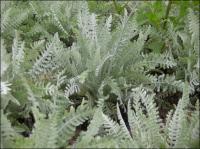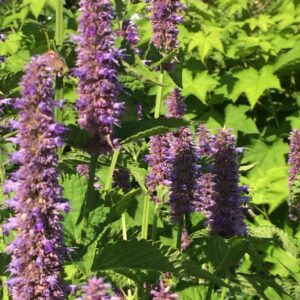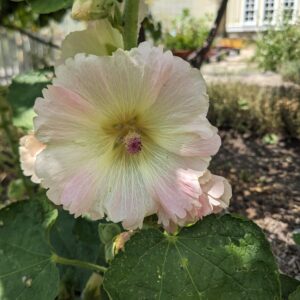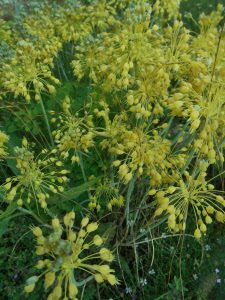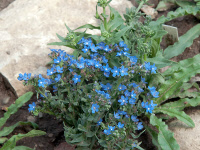Drought, Xeric & Dry Soil Plants
Showing 1–8 of 126 results
-
Achillea clypeolata Yarrow Z 3-9
Mustard yellow platters in summer on fern-like, thick clumps of gorgeous, silver dissected foliage.
Mustard yellow platters in summer on fern-like, thick clumps of gorgeous, silver dissected foliage.
Size: 18" x 24"
Care: sun in well-drained to moist well-drained soil.
Native: BalkansAchillea named for Achilles, hero of Homer’s Illiad, who used Achillea millefolium to stop bleeding of his wounded soldiers. Clypeolata means “with a shield.” Described in 1813 in Fl. Graec. Prodr. 2: 193 (1813) giving credit to French botanist Joseph Tournefort (1656-1708.)
-
Achillea filipendulina Fernleaf Yarrow Z 3-10
June-July mustard yellow platters on erect stems. Good dried flowers.
June-July mustard yellow platters on erect stems. Good dried flowers.
Size: 3’-4’ x 30”
Care: Full sun in well-drained to moist-well-drained soil. Heat and drought tolerant
Native: Caucasus, Iran, Afganistan.Achillea named for Achilles, hero of Homer’s Iliad, used Achillea millefolium to stop bleeding of his wounded soldiers at the siege of Troy. Achilles learned about the uses of Achillea from Chiron, the Centaur. Introduced to gardens in 1804 when it was sent from the Caucasus to Europe.
-
Agastache foeniculum Anise hyssop Z 4-8
Purplish-blue spikes from July to October, very fragrant.
Purplish-blue spikes from July to October, very fragrant.
Size: 2-3' x 12"
Care: Full sun in well-drained soil, heat and drought tolerant.
Native: North America
Wildlife Value: Skipper butterflies and Rusty patched Bumble Bees love Anise hyssop’s nectar, Deer resistant.The name Agastache is from Greek agan and stachys meaning much like an ear of wheat referring to the shape of the flower spike. Anise hyssop leaves were used by American Americans of the Missouri River region to make tea and as a sweetener in cooking. For Cheyenne it relieved chest pain due to coughing or to a dispirited heart. Listed as an aromatic herb in Bernard McMahon’s 1805 book, American Gardener’s Calendar.
-
Alcea rosea Hollyhock BIENNIAL Z 4-9
Early to late summer spikes of single platters - mixed colors. The classic cottage garden flower.
Early to late summer spikes of single platters – mixed colors. The classic cottage garden flower.
Size: 2-5' x 2'
Care: Sun in well-drained soil.
Native: West Asia
Wildlife Value: Butterfly plant, host for Painted Lady butterfliesHollyhocks have been cultivated in China for thousands of years where it symbolized the passing of time. They cooked the leaves for a vegetable and, also ate the buds. Transported from Middle East to Europe by the Crusaders and introduced to England by 1573. Grown in the Eichstätt Garden, the garden of Johann Konrad von Gemmingen, prince bishop of Eichstätt in Bavaria, c. 1600. Culpepper, a 17th century English herbalist, claimed the plant could be used to cure ailments of the “belly, Stone, Reins, Kidneys, Bladder, Coughs, Shortness of Breath, Wheesing, … the King’s Evil, Kernels, Chin-cough, Wounds, Bruises, Falls. . . (and) Sun-burning.” Both single and double forms grew in England by the time of Parkinson (1629). Parkinson said they came “in many and sundry colours.” John Winthrop Jr. introduced the 1st hollyhock to the New World in the 1630’s. Grown at America’s 1st botanic garden, Elgin Botanic Garden 1811.
In the 1880’s Mr. W. Charter of Saffron Walden in England cultivated frilly doubles, now known as ‘Charter’s Doubles.’
-
Allium flavum var. minus Yellow flowered garlic
Umbels of shatter-shot yellow florets, like fireworks, bloom atop blue-green stems in July.
Umbels of shatter-shot yellow florets, like fireworks, bloom atop blue-green stems in July.
We are very sorry, but due to state agricultural restrictions, we are not permitted to ship Allium bulbs to Idaho, or to the following five counties in the State of Washington: Adams, Benton, Franklin, Grant and Klickitat.
Size: 10” x 3”
Care: sun in moist well-drained soil
Native: Northern Turkey
Wildlife Value: Resists critters including deer, rabbits, squirrels, mice, and moles and voles. They cannot stand the onion-like smell of Alliums protecting near-by plants too. Attracts bees & butterflies
Awards: species received Royal Horticultural Society Award of Garden MeritDescribed by Swiss botanist Pierre Edmond Boissier before 1885
-
Allium senescens Corkscrew allium, German garlic, Greater mountain garlic Z 4-9
Lavender balls, up to 30 of them, atop thin, bluish, strap-like, twisting foliage – mid-summer day’s dream.
Lavender balls, up to 30 of them, atop thin, bluish, strap-like, twisting foliage – mid-summer day’s dream.
We are very sorry, but due to state agricultural restrictions, we are not permitted to ship Allium bulbs to Idaho, or to the following five counties in the State of Washington: Adams, Benton, Franklin, Grant and Klickitat.
Size: 6-12” x 6-12”
Care: sun to part shade in well-drained to moist well-drained soil
Native: Siberia
Wildlife Value: Attracts butterflies & bees. Resists critters including deer, rabbits, squirrels, mice, and moles and voles. They cannot stand the onion-like smell of Alliums protecting near-by plants too.Cultivated before 1753. According to Philip Miller’s 1768 Dictionary, “planted in gardens for the variety of their flowers.” Grown at America’s 1st botanic garden, Elgin Botanic Garden 1811.
-
Amsonia orientalis syn. Rhazya orientalis European bluestar Z 5-8
“Immensely tough and useful filler” “100 Plants Every Gardener Should Grow,” Gardens Illustrated No. 231 Purplish blue terminal flower clusters are larger and longer lasting than other Amsonia. Yellow foliage in Fall.
“Immensely tough and useful filler” “100 Plants Every Gardener Should Grow,” Gardens Illustrated No. 231
Purplish blue terminal flower clusters are larger and longer lasting than other Amsonia. Yellow foliage in Fall.Size: 12-20” x spreading
Care: sun to light shade in moist well-drained soil
Native: TurkeyDeer resistant, salt and heat tolerant. Classified as critically endangered as it is losing its native habitat and was over harvested. Collected before 1844.
-
Anchusa capensis Cape forget-me-not, Cape bugloss Z 6-9
Truest of blue flowers from summer through fall
OUT OF STOCK
Truest of blue flowers from summer through fall. Do you need to know anything else?
Reseeding annual in colder zones.
Size: 8” x 8”
Care: sun in well-drained to moist well-drained soil
Native: So. Africa.
Awards: Plant Select® Central Rocky Mountain regionCollected and introduced to Europe in 1794 by von Thunberg (1743-1828). Carl Peter von Thunberg, student of Linnaeus at Uppsala University in Sweden, made three trips to the Cape of Good Hope 1772-1775 where he collected about 1000 new species, Java and Ceylon (Sri Lanka) 1777 and 15 months in Japan where he befriended local doctors who gave him hundreds of plants new to Western horticulture. He succeeded Linnaeus as professor of medicine and botany at Uppsala and King Gustav beknighted him. Young Cape forget-me-not plants were eaten as a vegetable, Annals of the South African Museum, 1898. Louise Beebe Wilder loved this plant, effusing, “One of the prettiest (blue annuals) is the Cape Forget-me-not. Not one of its cerulean family boasts a purer blue and its summer-long period of bloom and indifference to drought make it a really valuable annual. It has also a sturdy habit of growth and sowing its hardy seeds freely it does its best to become a permanent resident.” Robinson called it “Remarkably fine…” The Garden 1873. The name Anchusa from anchousa paint used on skin.

